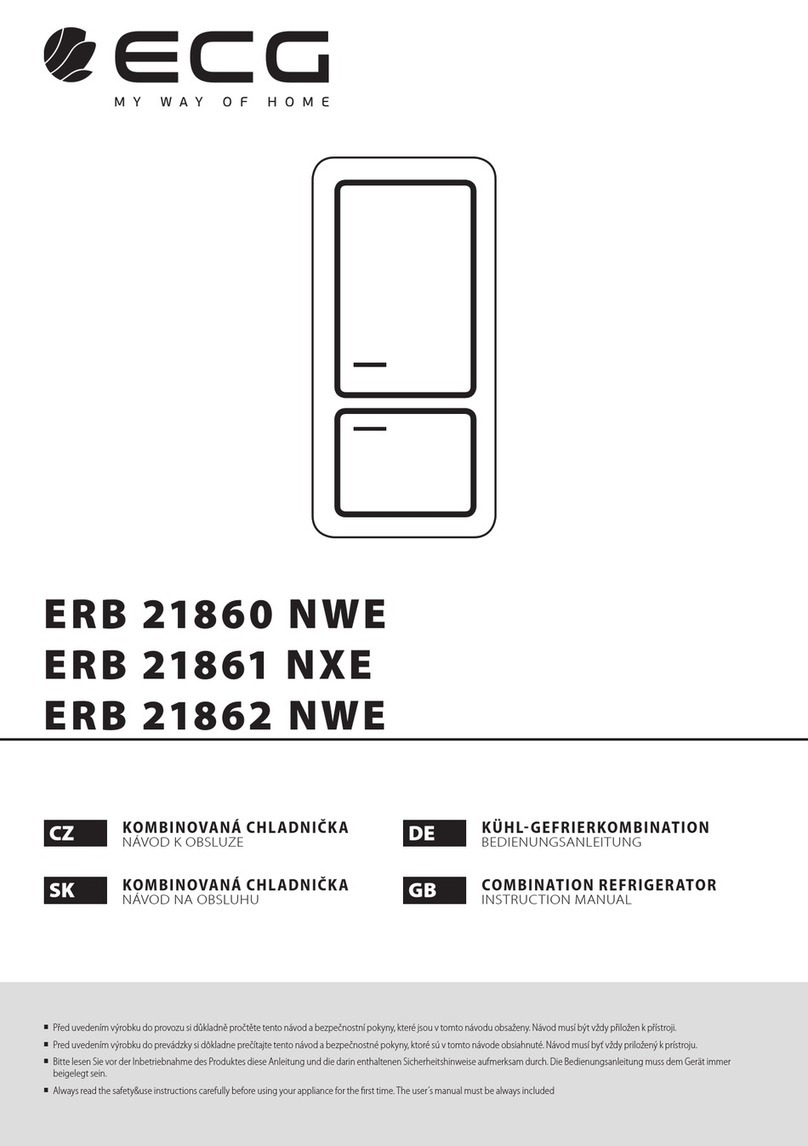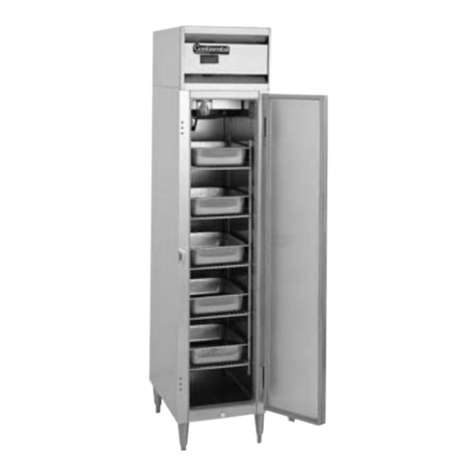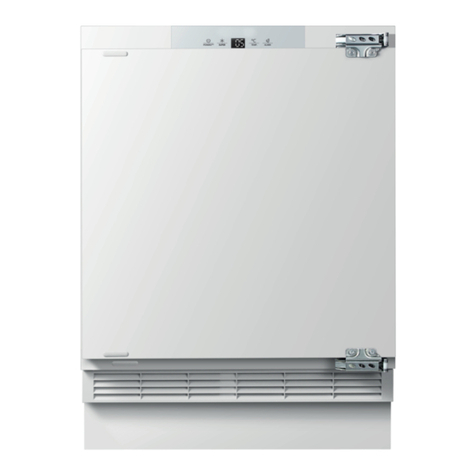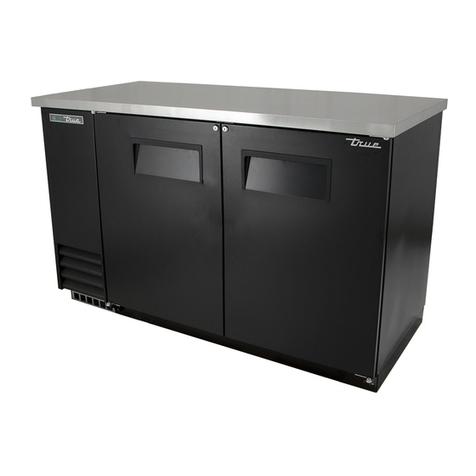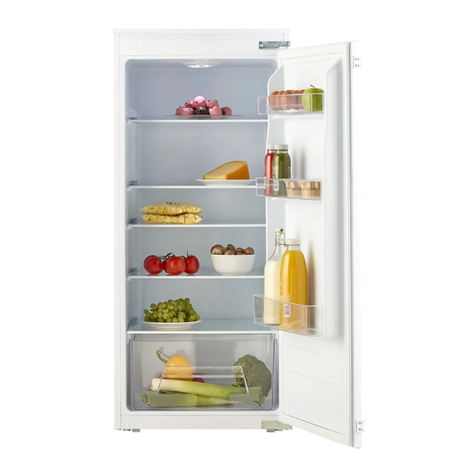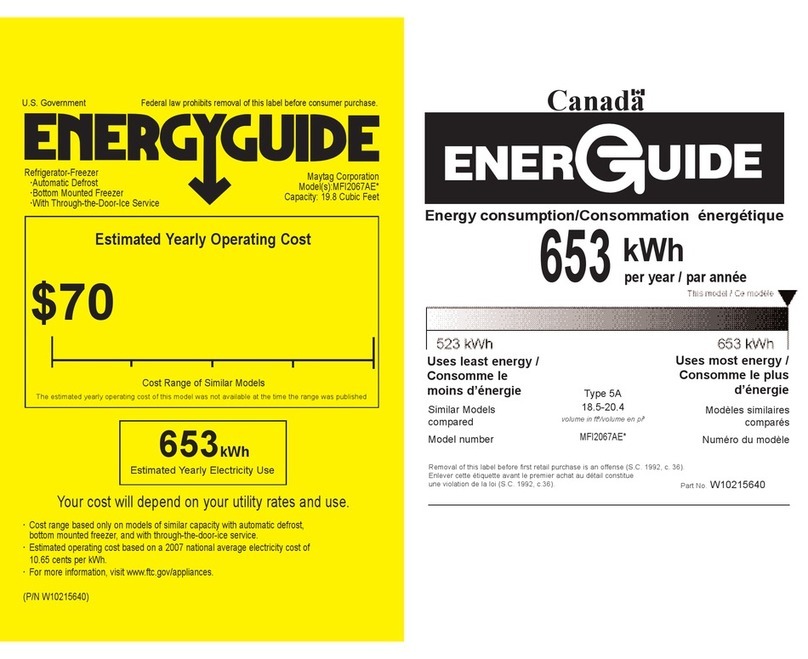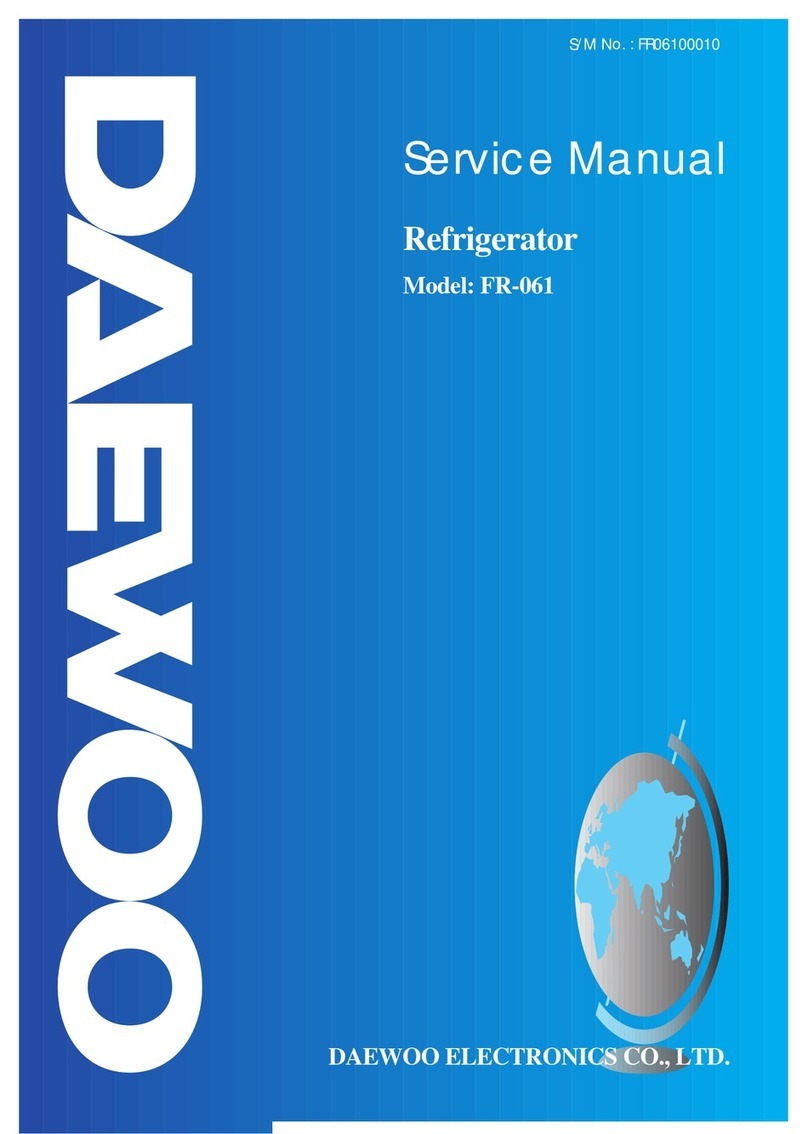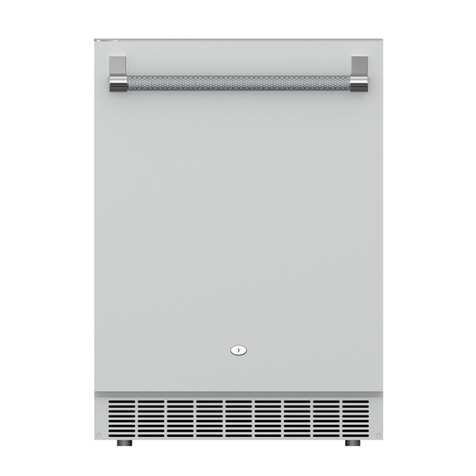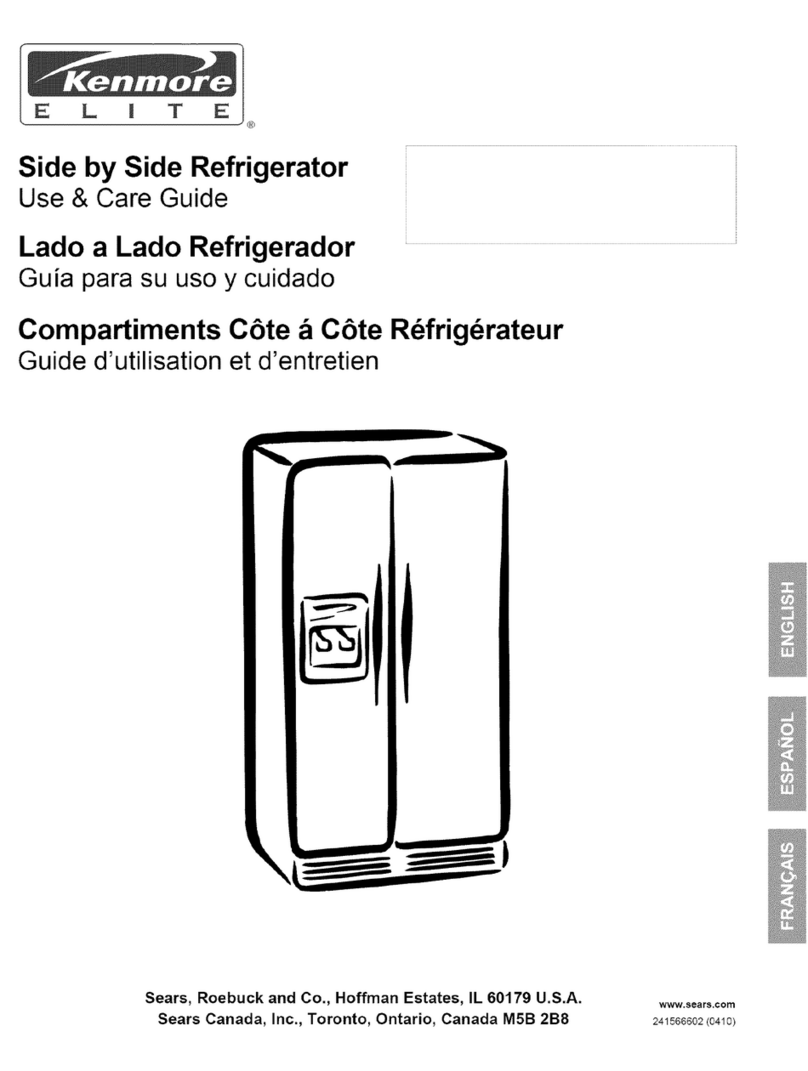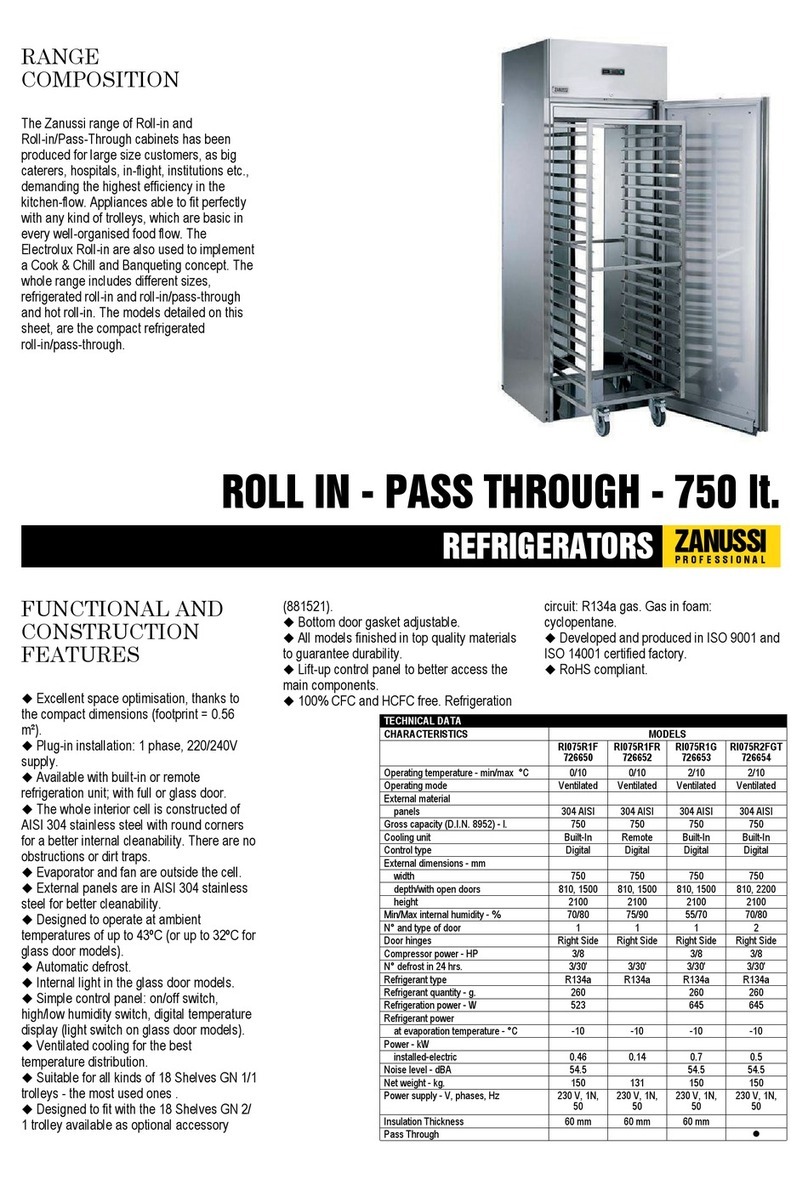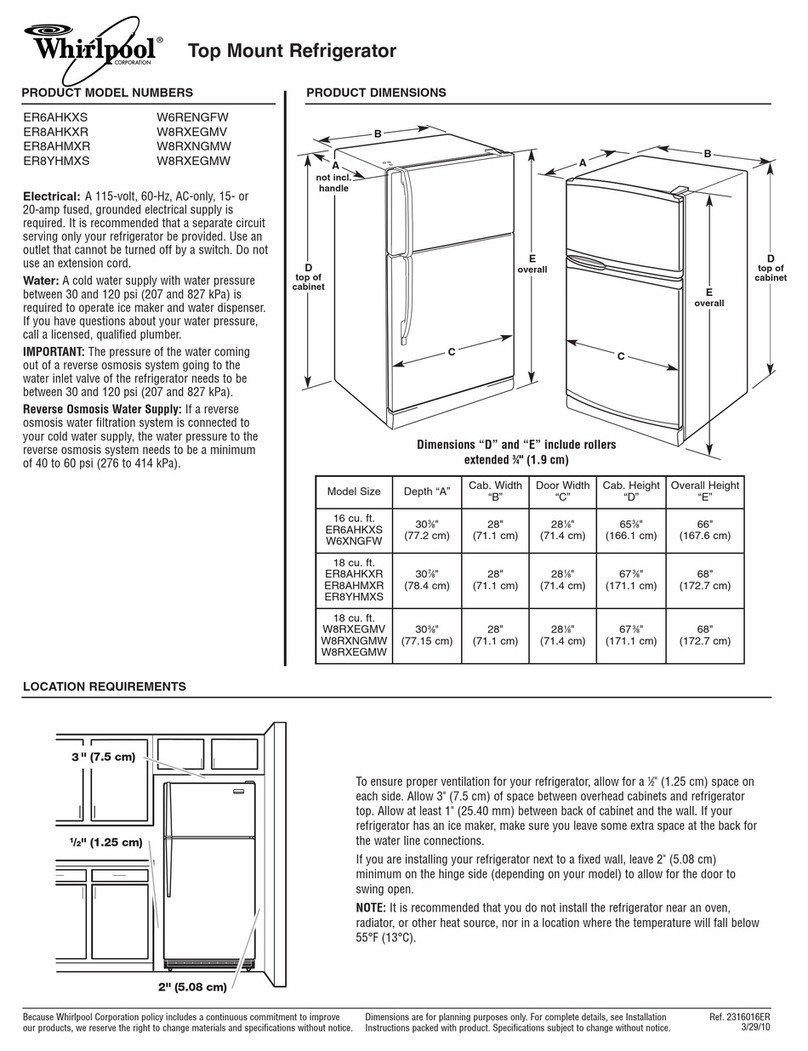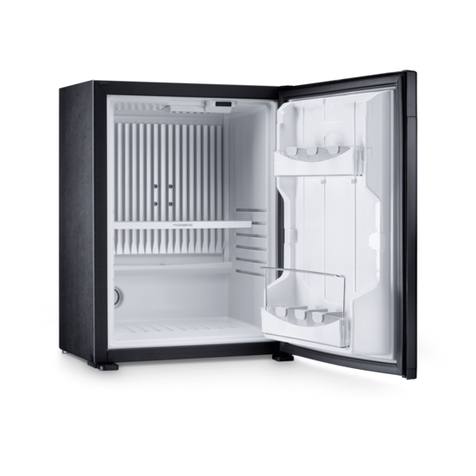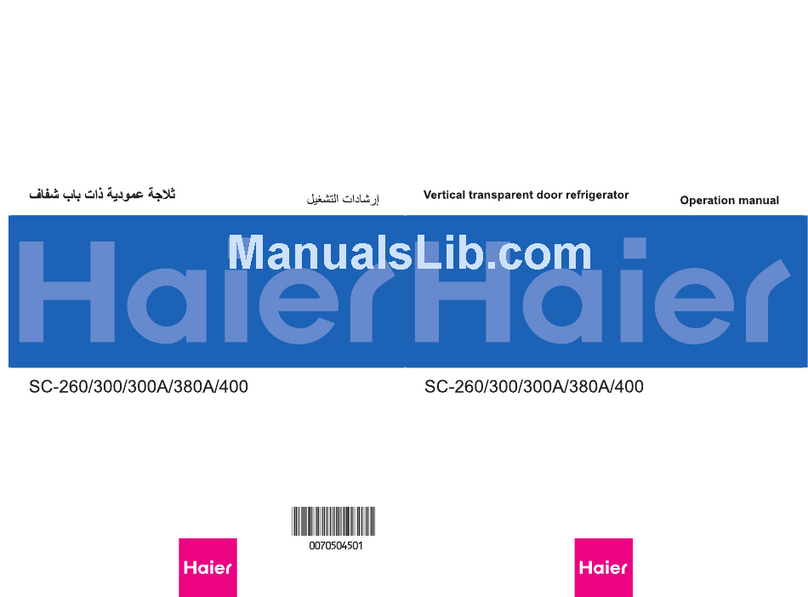ECG ERT 10860 WE User manual

ERM 10470 WF
ERT 10860 WE
ERT 10841 WF
ERT 10850 WF
ERT 10853 WF
English
Deutsch
Čeština
Eesti keel
Hrvatski
Bosanski
Latviešu valoda
Lietuvių kalba
Magyar
Slovenčina
Slovenščina
Always read the safety&use instructions carefully before using your appliance for the rst time. The user´smanual must be always included. Bitte lesen Sie vor der Inbetriebnahme des Produktes diese Anleitung und
die darin enthaltenen Sicherheitshinweise aufmerksam durch. Die Bedienungsanleitung muss dem Gerät immer beigelegt sein. Před uvedením výrobku do provozu si důkladně pročtěte tento návod abezpečnostní
pokyny, které jsou vtomto návodu obsaženy. Návod musí být vždy přiložen kpřístroji. Enne seadme esmakordset kasutamist lugege ohutus- ja kasutusjuhised alati hoolikalt läbi. Kasutusjuhend peab alati kaasas
olema. Uvijek pročitajte sigurnosne upute iupute za uporabu prije prvog korištenja vašeg uređaja. Upute moraju uvijek biti priložene. Pirms ierīces pirmās lietošanas reizes vienmēr rūpīgi izlasiet drošības un
lietošanas norādījumus. Rokasgrāmata vienmēr jāpievieno ierīcei. Prieš naudodamiesi prietaisu pirmąjį kartą, visuomet atidžiai perskaitykite saugos ir naudojimo instrukcijas. Kartu su gaminiu visada privalo
būti jo naudotojo vadovas. Atermék használatba vétele előtt gyelmesen olvassa el ezt a használati útmutatót és az útmutatóban található biztonsági rendelkezéseket. A használati útmutatót tartsa akészülék
közelében. Pred uvedením výrobku do prevádzky si dôkladne prečítajte tento návod abezpečnostné pokyny, ktoré sú vtomto návode obsiahnuté. Návod musí byť vždy priložený kprístroju.
Pred vklopom izdelka
temeljito preberite ta navodila in varnostne napotke, ki so navedeni vteh navodilih. Navodila morajo biti vedno priložena knapravi..
REFRIGERATOR
INSTRUCTION MANUAL
LEDUSSKAPIS
ROKASGRĀMATA
KÜHLSCHRANK
BEDIENUNGSANLEITUNG
ŠALDYTUVAS
INSTRUKCIJŲ VADOVAS
CHLADNIČKA
NÁVOD K OBSLUZE
HŰTŐSZEKRÉNY
HASZNÁLATI ÚTMUTATÓ
KÜLMIK
KASUTUSJUHEND
CHLADNIČKA
NÁVOD NA OBSLUHU
HLADNJAK
UPUTE ZA UPORABU
HLADILNIK
NAVODILA


English
English
3
REFRIGERATOR
SAFETY INSTRUCTIONS
Read carefully and save for future use!
Warning: The safety measures and instructions, contained in this
manual, do not include all conditions and situations possible. The user
must understand that common sense, caution and care are factors that
cannot be integrated into any product.Therefore, these factors shall be
ensured by the user/s using and operating this appliance. We are not
liable for damage caused during transportation, improper use, voltage
uctuation or any change or modication of any part of the appliance.
To protect against a risk of re or electric shock, basic precautions shall
be taken while using electrical appliances, including the following:
1. Make sure the voltage in your outlet corresponds to the voltage
provided on the appliance label and that the socket is properly
grounded. The outlet must be installed in accordance with
applicable electrical codes according to EN.
2. Do not operate the device if the cord is damaged. All repairs or
adjustments including cord replacements shall be performed
by a professional service centre! Do not remove the protective
covers from the appliance; there is a risk of electric shock!
3. Protect the appliance against direct contact with water and other
liquids, to prevent potential electric shock. Do not immerse cord or
plug in water!
4. Do not use the appliance in humid environments or in areas where
there may be gas leakage or contact with an explosive atmosphere.
Do not touch the cord or the device with wet hands. Risk of electric
shock.
5. The power cord must remain accessible once the device is installed.
Do not shorten the cable and do not use splitters in electric outlets.
Do not allow the cord to touch hot surfaces or place the cord over
sharp edges.
6. Do not switch the appliance on or o by plugging in or pulling out
the power supply plug. Do not remove the power cord from the
REFRIGERATOR
English

English
English
4
outlet by yanking the cord. Unplug the power cord from the outlet
by grasping the plug.
7. Do not insert any objects into the device or place any objects on the
device (e.g. vases, cups, etc.). Never cover the ventilation openings!
8. Do not use other electrical appliances or freezing equipment in the
appliance.
9. If this appliance is replacing an old appliance with a lock, make the
lock of the old appliance inoperational to prevent children from
locking themselves inside (e.g. when playing).
10.Do not use mechanical devices or other articial means to speed
up defrosting. Do not use electrical appliances in the food storage
area. Protect the cooling circuit of the appliance against damage.
11.Do not allow children to play with the appliance. Also, they may not
sit on the shelves and hang on the door of the appliance.
12.Do not use sharp metal objects to remove ice in the refrigerator,
as they can damage the freezing circuits and cause irreparable
damage to the equipment. If necessary, use a plastic scraper.
13.Do not store explosive materials such as sprays with propellant in
the appliance.
14.Do not place containers (glass bottles or cans) with liquids in the
freezer. The container could burst.
15.Bottles containing liquids with high alcohol content must be
properly closed and placed vertically when stored.
16.Do not expose the appliance to direct sunlight, do not use it outside
and do not expose it to rain.
17.Do not touch the cooling surfaces with wet hands. Risk of injury.
18.Do not consume the ice removed from the freezer.
19.This appliance is designed for domestic use and for use in similar
places, such as:
- Kitchenettes in shops, oces and other workplaces
- appliances used by guests in hotels, motels and other residential
areas.
- appliances used in bed and breakfast residences

English
English
5
20.This appliance may be used by children under 8 years of age
and older and persons with reduced physical, sensory or mental
capabilities or lack of experience and knowledge if supervised or
instructed to use the appliance in a safe manner and understand the
potential hazards. Children shall not play with the appliance. User
cleaning and maintenance must not be performed by unsupervised
children.
21.Children aged 3 to 8 years can insert and remove food from
refrigerating appliances.
22.Child supervision is essential to prevent them from playing with the
appliance.
23.The manufacturer is not liable for any damage caused by improper
grounding/use.
24.It is necessary to keep free the ventilation openings in the cover or
in the construction of the appliance.
To prevent food contamination, please follow these recommendations:
- Opening the door for a long time can cause a signicant increase
in the temperature inside the appliance.
- Regularly clean surfaces and accessible drainage systems that may
come into contact with food.
- Clean water containers if not used for 48 h; ush the water system
connected to the water supply if the water has not owed for 5
days.
- Store raw meat and sh in the refrigerator in suitable containers
so that they do not come into contact with or drip into other
foodstus.
- Two-star freezing compartments are suitable for storing pre-
frozen food, storing or making ice cream and making ice cubes.
- One-, two- and three-star compartments are not suitable for
freezing fresh food.
- If the refrigerating appliance is left empty for a long time, turn it
o, defrost, clean, dry and leave the door open to prevent mold
formation inside the appliance.

English
English
6
RISK OF FIRE!
WARNING: RISK OF FIRE/FLAMMABLE
MATERIALS
This appliance contains R600a (isobutane coolant), natural (natural)
gas that is very environmentally friendly but ammable. When
transporting and installing the appliance it is necessary to ensure that
none of the parts of the cooling circuit is damaged. In case of damage
limit the ame and ventilate for several minutes the space where the
appliance is located.
The cooling system contains high-pressure coolant. Do not manipulate
the system. It must only be repaired by a qualied person.
When replacing the interior lighting of the refrigerator, always unplug
the refrigerator - otherwise there is a risk of electric shock. • If the
replacement of the interior lighting is too complicated for you, contact
your service representative. • If the products are equipped with LEDs,
do not remove the lighting cover and LED yourself. – contact your
service representatives.
REPLACING THE LED BULB: Do not remove the indicator cover or
indicator yourself when the internal or external LEDs no longer operate.
Contact the service representatives.

English
English
7
The description and information of the appliance may vary according to the type of model.
DESCRIPTION
This type of refrigerator can be used widely in places like hotels, oces, student dormitories, and households.
It is ideal for cooling and storing food such as fruits and beverages. Its advantages are small dimensions, low
weight, low power consumption and easy use.
This description is only for information on the components of the appliance. Individual parts may dier
according to the particular appliance model.
1. Fruit and vegetable storage compartment
2. Refrigerator shelves
3. Thermostat and light*
4. Evaporator/freezer*
5. Door compartments
6. Adjustable feet
* diers according to the specic model of the
appliance – see information sheet
INSTALLING AND TURNING ON
THE APPLIANCE
Placement
• Do not tilt the refrigerator more than 45 ° from the vertical position during transport. Protect the
refrigerator from mechanical stresses. Deformation, especially in the area of the door and the evaporator,
could adversely aect the performance of the refrigerator.
• Leave enough space around the refrigerator necessary for its proper functioning.
• Do not place the refrigerator in hot or humid locations to prevent damage due to moisture and corrosion.
• Do not place heavy objects on the refrigerator.
• The refrigerator must stand rmly and in level position. Use the two adjustable front feet for levelling.
Connection
• Make sure that the AC voltage corresponds to the rated voltage on the appliance's label before plugging
it in. The power cord of the appliance should be plugged into a separate outlet, splitters can cause
overheating of the fork and cord.
• The outlet has to be accessible after you place the appliance.
Climate classes and meaning: see information sheet
T (tropical): This refrigerator is intended for use at ambient temperatures between 16 °C and 43 °C.
ST (subtropical): This refrigerator is intended for use at ambient temperatures between 16 °C and 38 °C.
N (normal): This refrigerator is intended for use at ambient temperatures between 16 °C and 32 °C.
SN (subnormal): This refrigerator is intended for use at ambient temperatures between 10 °C and 32 °C.
Climatic classes Surrounding
T16 up to 43°C
ST 16 up to 38°C
N16 up to 32°C
SN 10 up to 32°C
3
1
6
5
5
4
2

English
English
8
Changing the door opening side
Tools needed to change the door opening side
Phillips screwdriver Small at screwdriver, scraper
Ratchet with extension size 5/16” (8
mm) Adhesive tape
1. Turn o the refrigerator and remove everything from the door shelves.
2. Secure the door with adhesive tape.
3. Remove the left opening cover of the upper hinge, the upper hinge cover (on the right) and unscrew the
upper hinge bolts, then remove the upper hinge. Hold the door in vertical position all the time and make
sure it does not fall.
Upper hinge cover
Upper hinge
4. Remove the door, remove the lower hinge and the adjustable leg. Then install the lower hinge on the left
side of the freezer and the adjustable leg on the right side.
Adjustable leg Bottom hinge
Bottom hinge (dierent version)
5. Install the door on the lower hinge and check that the seal is sealing properly and that the door position is
correct. Install the upper left hinge and attach hinge cover.

English
English
9
Upper hinge cover
Upper hinge
The above procedure and drawings are illustrative only. The particular door hinge version may vary. Consult a
service technician if necessary.
OPERATING INSTRUCTIONS
Start and operation
• Before rst use, turn the refrigerator on without food and allow it to stabilize at the selected temperature.
That takes about 2 to 3 hours. Then set the thermostat control to the desired temperature and place the
food in the refrigerator.
• You can set the temperature in the refrigerator using the thermostat control. For normal operation, it is
best to set the controller to a medium value.
• Whenever a layer of ice forms with a thickness of 3 to 4 mm on the surface of the evaporator, defrost the
refrigerator, see "Defrosting" section.
Thermostat adjustment
• The thermostat automatically regulates the internal temperature of the refrigeration and freezer
compartment of the refrigerator. Turn the switch from position 1 to position 5 to obtain a cooler
temperature inside.
• The "•“ position shows that the thermostat is switched o and the cooling is switched o.
• For short-term food storage in the freezer, adjust the switch between position 1-3 as needed.
• For long-term food storage in the freezer, adjust the switch to position 3 or 4.
Note: the ambient temperature, the temperature of freshly stored foodstus and how often the door is opened
aect the temperature inside the refrigerator. If necessary, adjust the thermostat at your discretion.
• When switching on the refrigerator for the rst time, the appliance should operate for at least 24 hours
before it reaches a suciently cool internal temperature.
• During this time, do not open the door too often and place more food inside.
• If the refrigerator is switched o, wait at least 5 minutes before restarting - this will prevent damage to the
compressor.

English
English
10
Functions
• Turn the knob counterclockwise, the temperature inside the box becomes
higher; turn the knob clockwise, the temperature inside the box becomes
lower.
• Please adjust between COOL and COOLER gear.
• Recommended gear: NORMAL.
• When the knob is turned to OFF, it means that the compressor stops running.
Tips for proper use
• Inserting larger quantities of food at one time, frequent door opening or long
time open door leads to an increase in electricity consumption.
• Do not put in the refrigerator objects that are too heavy or sharp or aggressive
materials.
• To reduce moisture and subsequent ice build-up, never put liquid into the refrigerator in unsealed
containers. Frost tends to concentrate in the coolest parts of the evaporator. Storing uncovered liquids
results in a more frequent need for defrosting.
• Never put warm foods in the refrigerator. These should rst cool down at room temperature and then be
placed so as to ensure adequate air circulation in the refrigerator.
• Foods or food containers should not touch the back wall of the refrigerator because they could freeze
to the wall. After disconnecting the refrigerator from the power supply wait at least 10 minutes before
plugging it in again.
• Do not store bottles in the freezing compartment.The packaging could break and damage the refrigerator.
• In case of power failure, open the refrigerator as little as possible.
• When defrosting, never use sharp or metallic objects to remove ice from the evaporator.You could damage
the evaporator.
• Do not touch the foods and containers in the freezer compartment with wet hands to avoid the risk of
frostbite.
Using the refrigerator at home
• Try no to open the door too often, especially during hot and humid weather. When you open the door,
remember to close it as soon as possible.
• Check from time to time if there is sucient ventilation (adequate air circulation behind the appliance).
• Under normal temperature condition at home set the thermostat to the medium value.
• Before putting food in the refrigerator, let it cool rst to room temperature.
• The layer of ice increases energy consumption, therefore defrost the refrigerator as soon as the ice layer
reaches a thickness of 3-5 mm.
• If the refrigerator is equipped with an external cooler, the wall behind the refrigerator should always be
clean and free of dust and dirt.
• Always keep in mind the instructions in the "Location" section. Otherwise, the refrigerator consumption
may increase signicantly.
• Under normal operating conditions, it is sucient to adjust the temperature of the refrigerator to +4 °C.
• The temperature of the cooling compartment should be in the range of 0–8 °C, fresh foods are frozen
and rotten at temperatures below 0 °C, and bacteria increase and food spoils at temperatures above 8 °C.
• Do not refrigerate hot foods, let them cool to room temperature. Hot foods increase the temperature of
the refrigerator and can cause food poisoning or unnecessary food spoilage.
• Meat, sh and similar foods should be stored in chiller and vegetables in the vegetable compartment (if
applicable).
• Do not store meat products with fruit and vegetables to avoid cross-contamination.
• Food in a refrigerator should be stored in closed containers or other suitable packaging so as not to release
odours and moisture into the refrigerator.

English
English
11
Door open indicator - depends on the model.
• The "door open » indicator on the handle shows whether the door is open or has been
properly closed.
• If the indicator is red, the door is still open.
• When the indicator is white, the door is properly closed.
• Pay attention to the door so that it is always carefully closed. This prevents defrosting
of food and freezing of the walls of the appliance; increased power consumption is also
a matter of course.
CLEANING AND MAINTENANCE
• Before you start cleaning the refrigerator, remove the power cord plug from the outlet.
• Carefully wipe the refrigerator with a cloth soaked in a mild detergent solution. Do not use abrasive
cleaners, alkaline cleaners and alkalis, chemical wipes, thinner, alcohol, acids, gasoline cleaners, or hot
water. You could damage the surface nish and plastics.
• The door seal is easily clogged, clean it regularly.
• If the refrigerator is not used for long periods, unplug the power cord from the outlet, dry the freezer
compartment and carefully close the door.
• Clean the condenser at the rear of the appliance at least once a year.You will increase eciency and reduce
power consumption.
Defrosting
• When defrosting, remove all the food from the refrigerator and set the thermostat dial to "OFF".
• Place a drip tray under the evaporator, which will collect the melted water.
• After the ice melts, pour away the melted water and wipe the interior of the refrigerator dry.
• You can switch the refrigerator on again by setting the thermostat to the desired temperature.
Replacement of the bulb in the refrigerator
For models that have a bulb*
1. Unplug the appliance from the power supply.
2. Press the hooks on the sides of the top of the cover and remove the bulb cover.
3. Replace the defective bulb with a new one with maximum power 15 W.
4. Install the bulb cover and connect the appliance to the power supply after 5 minutes.
For models with LED lighting*
Do not replace the LED lighting yourself. Contact the service representatives.
* diers according to the specic model of the appliance – see information sheet
TROUBLESHOOTING
You can solve a number of common problems on your own. If the refrigerator is not working properly, check
the following points before calling a service technician:
Cause Check
The refrigerator is not cooling. • Is the refrigerator turned on?
• Is the power supply all right?
• Did the fuses of the outlet on a circuit in which the refrigerator is
plugged fail?
• Is the power cord plug correctly inserted in the outlet?

English
English
12
Cause Check
Low eciency. • Is the thermostat set in correct position?
• Is there enough of free space around the refrigerator?
• Is the door opened too frequently or for long periods?
• Is the refrigerator exposed to direct sunlight or placed too close to heat
sources?
• Are there too many foods inside?
• Do you put in foods, which are too warm?
Frozen foods inside the
refrigerator.
• Is the thermostat set in correct position?
• Are the foods too cramped?
Noisy operation. • Is the refrigerator in a stable and horizontal position?
• Does the refrigerator touch other objects?
The compressor does not
automatically switch o.
• Did you put in too many foods?
• Is the door opened too frequently or for long periods?
If the above mentioned tips do not solve the problem, contact the service centre immediately.
The following does not indicate a malfunction
The sound of running liquid:
• You can hear the sound of running liquid during a normal operation.
Exterior condensation:
• The condensation on the surface is a normal sign during high ambient humidity. You simply wipe o the
wet surface.
Achieving the desired temperature
• After switching on, it takes some time for the temperature in the refrigerator to drop to the desired level.
When the ambient temperature is high, the cooling takes longer time.
The surface of the compressor heats up.
• The surface of the compressor can become hot during normal operation. Do not touch it with bare hands.
USE AND DISPOSAL OF WASTE
Wrapping paper and corrugated paperboard – deliver to scrapyard. Packing foil, PE bags, plastic elements – throw into plastic
recycling containers.
DISPOSAL OF PRODUCTS AT THE END OF LIFETIME
Disposal of electric and electronic equipment (valid in EU member countries and other European
countries with an implemented recycling system)
The represented symbol on the product or package means the product shall not be treated as domestic waste.
Hand over the product to the specied location for recycling electric and electronic equipment. Prevent negative
impacts on human health and the environment by properly recycling your product. Recycling contributes to
preserving natural resources. For more information on the recycling of this product, refer to your local authority,
domestic waste processing organization or store, where you purchased the product.
This product complies with EU directives on electromagnetic compatibility and electrical safety.
This product meets the requirements for heavy metals in electrical equipment.
The operating manual is available on internet at www.ecg-electro.eu.
Changes of text and technical parameters reserved.
Old refrigerators and freezers contain insulating gases and freezing medium, which must be disposed of.
Entrust the disposal to a competent local waste disposal service. If in doubt, contact your local authorities or
your vendor. Make sure that the pipes of the cooling unit, which will be removed by the appropriate waste
disposal,service are not damaged.
08/05

English
English
13
• Contact for professional servicing of this product can be found in the enclosed Warranty Certicate or on
the website www.ecg-electro.eu.
• The warranty for this product is 24 months.
• Spare parts listed in EU 2019/2019 are available for 7 years.
• You can access the product database, where information about this product is stored according to EU
2019/2016, by reading the QR code on the energy label.

Deutsch
Deutsch
14
KÜHLSCHRANK
SICHERHEITSHINWEISE
Bitte aufmerksam lesen undgut aufbewahren!
Warnung:DieindieserAnleitungangeführtenSicherheitsvorkehrungen
und Hinweise umfassen nicht alle Umstände und Situationen, zu denen
es kommen könnte. Der Anwender muss begreifen, dass der gesunde
Menschenverstand, Vorsicht und Sorgfalt zu Faktoren gehören, die
sich in kein Produkt einbauen lassen. Diese Faktoren müssen durch
den Anwender bzw. mehrere Anwender bei der Verwendung und
Bedienung dieses Gerätes gewährleistet werden. Wir haften nicht
für Schäden, die durch Transport, eine unsachgemäße Verwendung,
Spannungsschwankungen sowie eine Änderung oder Modikation
des Gerätes entstehen. Um Bränden oder Stromunfällen vorzubeugen,
müssen bei der Verwendung von elektrischen Geräten u.a. folgende
Vorsichtsmaßnahmen eingehalten werden:
1. Vergewissern Sie sich, dass die Spannung an Ihrer Steckdose mit
der Spannung auf dem Etikett übereinstimmt und die Steckdose
ordnungsgemäß geerdet wurde. Die Steckdose muss gemäß
geltender elektrotechnischer Norm (EN) installiert werden.
2. Benutzen Sie das Gerät nicht, falls das Stromkabel beschädigt
ist. Lassen Sie sämtliche Reparaturen, Einstellungen und das
Auswechseln des Stromkabels durch einen autorisierten
Kundendienst vornehmen! Demontieren Sie niemals die
Schutzabdeckungen des Gerätes. Dies könnte zu einem
Stromunfall führen!
3. Schützen Sie das Gerät vor direktem Kontakt mit Wasser und
sonstigen Flüssigkeiten, um Stromunfällen vorzubeugen.
Stromkabel oder Stecker niemals ins Wasser tauchen!
4. Gerät niemals in einer feuchten Umgebung oder in Räumen
benutzen, in denen Gas entkommen könnte oder Kontakt mit einer
explosiven Atmosphäre droht. Stromkabel oder Gerät niemals mit
nassen Händen berühren. Es könnte zu einem Stromunfall kommen.
5. Der Netzstecker sollte auch nach der Installation des Gerätes leicht
erreichbar sein. Verkürzen Sie nicht das Kabel und benutzen keine
KÜHLSCHRANK
Deutsch

Deutsch
Deutsch
15
Mehrfachsteckdosen. Das Stromkabel darf nicht mit heißen Teilen
in Berührung kommen oder über scharfe Kanten führen.
6. Schalten Sie das Gerät nicht durch Ein-/Ausziehen des Steckers
ein oder aus. Ziehen Sie nicht am Kabel, um den Stecker aus der
Steckdose zu ziehen. Ziehen Sie am Stecker, um das Kabel aus der
Steckdose zu ziehen.
7. Stecken Sie keine Gegenstände in die Geräteönungen und
stellen auf das Gerät keine Gegenstände (z.B. Vasen oder Tassen).
Belüftungsönungen niemals verdecken!
8. Benutzen Sie innerhalb des Verbrauchsgerätes keine anderen
Elektrogeräte oder Gefrieranlagen.
9. Falls dieserVerbraucher ein ausgedientes Gerät mit Schloss ersetzen
soll, entfernen Sie zunächst das Schloss an diesem Gerät. Die Tür
könnte sich versehentlich abschließen und Kinder im Verbraucher
einsperren (z.B. beim Spielen).
10.Benutzen Sie weder mechanische Vorrichtungen noch sonstige
Hilfsmittel, um das Abtauen zu beschleunigen. Benutzen Sie keine
Elektrogeräte im Bereich, in dem Lebensmittel aufbewahrt werden.
Schützen Sie den Kühlkreislauf vor Beschädigungen.
11.Kinder dürfen nicht mit dem Gerät spielen. Weiter dürfen sie nicht
auf Regalen sitzen oder sich an die Tür des Verbrauchers hängen.
12.Benutzen Sie zum Entfernen von Eis keine scharfen
Metallgegenstände, da diese den Kühlkreislauf beschädigen und
zu irreparablen Schäden führen könnten. Falls nötig, benutzen Sie
eine Kunststospatel.
13.Lagern Sie im Verbraucher keine Sprengstoe wie z.B. Sprühdosen
mit Treibgas.
14.Sie sollten im Gefrierschrank keine Verpackungen (Glasaschen
oder Konserven) mit Flüssigkeiten aufbewahren. Das Gefäß könnte
zerspringen.
15.Flaschen mit Flüssigkeiten mit einem hohen Alkoholgehalt müssen
gut verschlossen und vertikal gelagert werden.
16.Setzen Sie das Gerät weder Sonnenlicht noch Regen aus. Benutzen
Sie das Gerät nicht im Freien.

Deutsch
Deutsch
16
17.Berühren Sie nicht die Kühlächen, vor allem nicht mit nassen
Händen. Mögliche Verletzung.
18.Verzehren Sie nicht das Eis, das aus dem Gefrierteil entfernt wurde.
19.Dieses Gerät ist für den Gebrauch im Haushalt und in vergleichbaren
Räumen bestimmt:
- KüchenzeileninGeschäften,BürosundansonstigenArbeitsplätzen
- Verbrauchsgeräte, die Gästen in Hotels, Motels und ähnlichen
Beherbergungseinrichtungen zur Verfügung stehen
- Verbrauchsgeräte in Betrieben mit Übernachtung und Frühstück
20.Kinder im Alter von 8 Jahren und älter sowie Personen mit
verminderten physischen, sensorischen und mentalen Fähigkeiten
sowie mangelnden Erfahrungen und Kenntnissen, dürfen dieses
Gerät nur unter Aufsicht benutzen, oder nachdem diese über
einen gefahrlosen Gebrauch belehrt wurden und mögliche
Gefahren verstehen. Kinder dürfen nicht mit dem Gerät spielen.
Die seitens des Verbrauchers vorgenommenen Reinigungs- und
Wartungsarbeiten dürfen Kinder nur dann vornehmen, falls diese
beaufsichtigt werden.
21.Kinder von 3 bis 8 Jahren können Lebensmittel in Kühlgeräte geben
und herausnehmen.
22.Kinder sollten beaufsichtigt werden, damit sichergestellt wird, dass
sie mit dem Gerät nicht spielen.
23.Der Hersteller haftet nicht für Schäden infolge einer falschen
Erdung/Anwendung.
24.Die Luftlöcher im Gehäuse des Gerätes oder in seiner Konstruktion
dürfen nicht verdeckt werden.
Um eine Kontamination der Lebensmittel zu vermeiden, sollten
folgende Hinweise befolgt werden:
- Durch das lange Önen der Tür könnte sich die Temperatur im
Innenbereich des Verbrauchers erheblich erhöhen.
- Reinigen Sie regelmäßig Oberächen, die in Kontakt
mit Lebensmitteln kommen könnten, und zugängliche
Ableitungssysteme.

Deutsch
Deutsch
17
- Wasserbehälter, die bis zu 48 Stunden nicht benutzt wurden,
sollten gereinigt werden. Falls Wasser für bis zu 5 Tagen nicht
durchgeossen ist, sollte das an die Wasserzufuhr angeschlossenes
Wassersystem durchgespült werden.
- Rohes Fleisch und Fisch sollten im Verbraucher in geeigneten
Verpackungen gegeben werden, damit diese nicht in Kontakt mit
anderen Lebensmittel kommen oder auf diese abtropfen.
- Zwei-Sterne-Gefrierbereiche sind vor allem zur Lagerung von
vorgekühlten Lebensmitteln und zur Lagerung oder Herstellung
von Eis und Eiswürfeln geeignet.
- Ein-, Zwei- oder Drei-Sterne-Bereiche sind nicht zum Tiefkühlen
von frischen Lebensmitteln geeignet.
- Sollte das Kühlgerät für längere Zeit leerstehen, ausschalten,
abtauen, reinigen, trocknen und oen stehen lassen, um der
Entstehung von Schimmel im Innenbereich vorzubeugen.
BRANDGEFAHR!
WARNUNG: BRANDGEFAHR / BRENNBARE
STOFFE
Dieses Gerät enthält R600a (Kühlmedium Isobutan) und Erdgas, das
zwar umweltfreundlich, aber brennbar ist. Während des Transportes
und der Installation muss beachtet werden, damit kein Abschnitt
des Kühlkreislaufes beschädigt wird. Falls der Kühlkreislauf dennoch
beschädigt wurde, beugen Sie einem möglichen Brand vor und sorgen
dafür, dass die Räume, in denen sich das Gerät bendet, einige Minuten
lang belüftet werden.
Das Kühlsystem enthält Hochdruckkühlmittel. Das System nicht
manipulieren. Es darf nur von einer qualizierten Person repariert
werden.

Deutsch
Deutsch
18
Verbraucher beim Auswechseln der Innenbeleuchtung vom Stromnetz
trennen - ansonsten könnte es zu einem Stromunfall kommen. • Sollte
das Auswechseln der Innenbeleuchtung für Sie zu kompliziert sein,
Wenden Sie sich an Ihren Ansprechpartner im Kundenservice. •Wurden
die Produkte mit LED-Dioden ausgestattet, sollten diese oder deren
Gehäuse niemals vom Kunden selbst demontiert werden. – Wenden
Sie sich an Ihren Ansprechpartner im Kundenservice.
AUSWECHSELN DER LED-LEUCHTE: Wenn die inneren oder äußeren
LED-Lichternichtmehrfunktionieren, solltendieseoderderenGehäuse
niemals vom Kunden selbst demontiert werden. Wenden Sie sich an
Ihren Ansprechpartner im Kundenservice.

Deutsch
Deutsch
19
Die Beschreibung und Informationen des Geräts können je nach Modelltyp variieren.
BESCHREIBUNG
Dieser Kühlschranktyp ndet eine breite Anwendung in zahlreichen Einrichtungen wie Hotels, Büros,
Studentenwohnheime und Haushalte. Ideal zum Abkühlen und Aufbewahren von Lebensmitteln wie Obst
und Getränke. Eine geringe Größe, ein geringes Gewicht, ein niedriger Stromverbrauch und eine einfache
Bedienung - das alles sind die Vorteile dieses Kühlschranks.
Diese Beschreibung informiert über einzelne Geräteteile. EinzelneTeile können in Abhängigkeit vom jeweiligen
Gerätemodell variieren.
1. Obst- und Gemüsefach
2. Kühlschrankregal
3. Thermostat und Licht*
4. Verdampfer/Gefrierschrank*
5. Türfächer
6. Verstellbare Füße
* unterscheidet sich je nach Gerätemodell - siehe
Merkblatt
INSTALLATION UND
EINSCHALTEN DES GERÄTES
Speicherort
• Der Kühlschrank sollte beimTransport nicht um mehr als 45° geneigt werden. Schützen Sie den Kühlschrank
vor mechanischer Belastung. Deformationen, vor alle im Bereich derTür und desVerdampfers, könnten die
Kühlleistung beeinträchtigen.
• Sorgen Sie rund um den Kühlschrank für ausreichend Freiraum, wodurch eine richtige Funktionsfähigkeit
gewährleistet wird.
• Platzieren Sie den Kühlschrank nicht Orte mit hohen Temperaturen oder hoher Luftfeuchtigkeit, damit
dieser nicht durch Feuchtigkeit oder Korrosion beschädigt wird.
• Stellen Sie keine schweren Gegenstände auf das Gerät.
• Der Kühlschrank muss stabil und waagerecht stehen. Benutzen Sie zum Ausgleichen die zwei verstellbaren
Vorderfüße.
Anschließen des Gefrierschranks
• Sie sollten sich vor dem Anschließen an das Stromnetz vergewissern, dass die Spannung in Ihrem Netz
mit der Nennspannung auf dem Geräteschild übereinstimmt. Das Stromkabel des Kühlschranks ist an eine
getrennte Steckdose anzuschließen. Abzweigstecker könnten zur Überhitzung von Stecker und Kabel
führen.
• Die Steckdose muss nach dem Aufstellen des Kühlschranks weiterhin gut erreichbar sein.
Klimaklasse und Relevanz: siehe Factsheet
T (tropisch): Dieser Kühlschrank ist für den Einsatz bei Umgebungstemperaturen zwischen 16 °C und 43 °C
vorgesehen.
ST (subtropisch): Dieser Kühlschrank ist für den Einsatz bei Umgebungstemperaturen zwischen 16 °C und 38
°C vorgesehen.
N (normal): Dieser Kühlschrank ist für den Einsatz bei Umgebungstemperaturen zwischen 16 °C und 32 °C
vorgesehen.
SN (subnormal): Dieser Kühlschrank ist für den Einsatz bei Umgebungstemperaturen zwischen 10 °C und 32
°C vorgesehen.
3
1
6
5
5
4
2

Deutsch
Deutsch
20
Klimaklassen Umgebung
T16 bis 43°C
ST 16 bis 38°C
N16 bis 32°C
SN 10 bis 32°C
Änderung der Önungsrichtung der Tür
Hilfsmittel für die Änderung der Önungsrichtung der Tür
Kreuzschlitz-Schraubendreher Schlitzschraubendreher
Knarre mit Aufsatz der Größe 5/16" (8
mm) Klebeband
1. Schalten Sie den Kühlschrank aus und nehmen alle Türregale heraus.
2. Fixieren Sie die Tür mit Klebeband.
3. Nehmen Sie die Abdeckung des linken oberen Türbandloches und die Abdeckung des oberen Türbandes
(auf der rechten Seite) ab. Schrauben Sie die Schrauben am oberen Türband ab und nehmen das obere
Türband ab. Die Tür sollte die ganze Zeit senkrecht gehalten werden. Geben Sie Acht, damit die Tür nicht
zu Boden stürzt.
Abdeckung des oberenTürbands
Oberes Türbands
4. Nehmen Sie die Tür ab, demontieren das untere Türband und den verstellbaren Fuß. Befestigen Sie das
untere Türband auf die linke Seite und den verstellbaren Fuß auf die rechte Seite des Kühlschranks.
This manual suits for next models
4
Table of contents
Languages:
Other ECG Refrigerator manuals
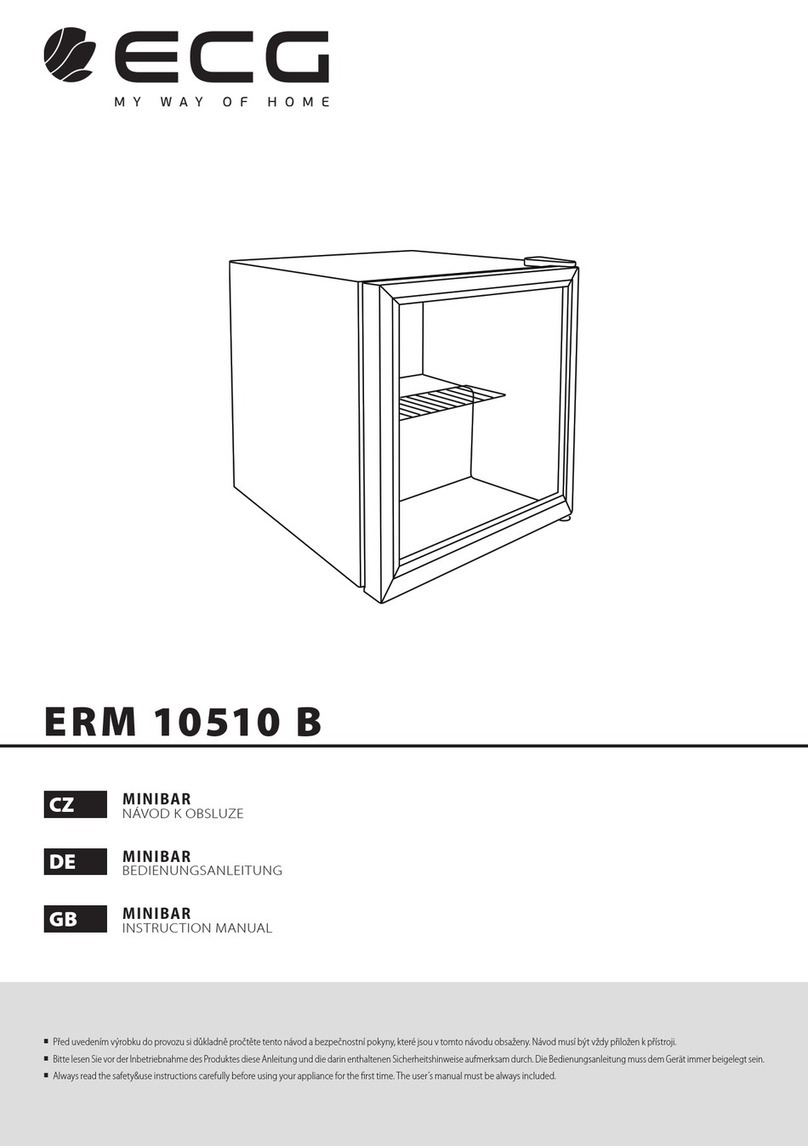
ECG
ECG ERM 10510 B User manual

ECG
ECG ERM 10510 BRM User manual

ECG
ECG ERM 10470 WF User manual

ECG
ECG ERB 21860 NWE User manual
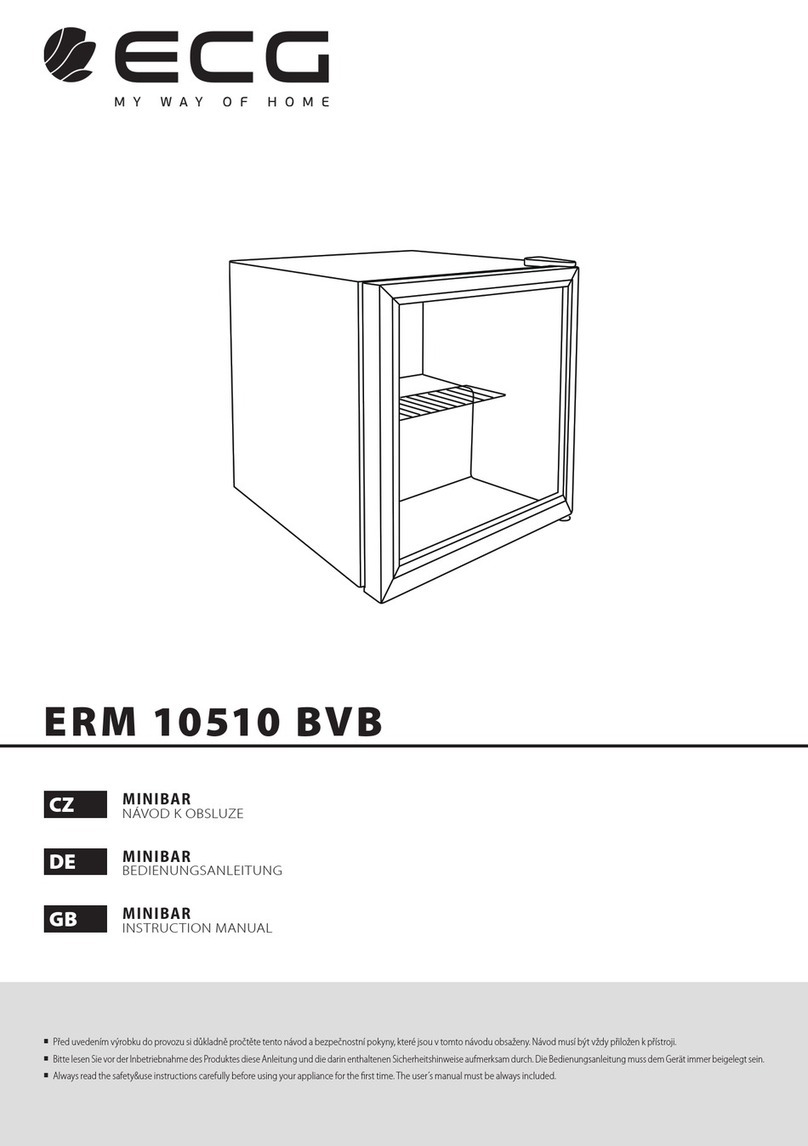
ECG
ECG ERM 10510 BVB User manual

ECG
ECG ERB 21700 WA+ User manual

ECG
ECG ERB 21861 NXE User manual

ECG
ECG ERS 21780 NWF User manual
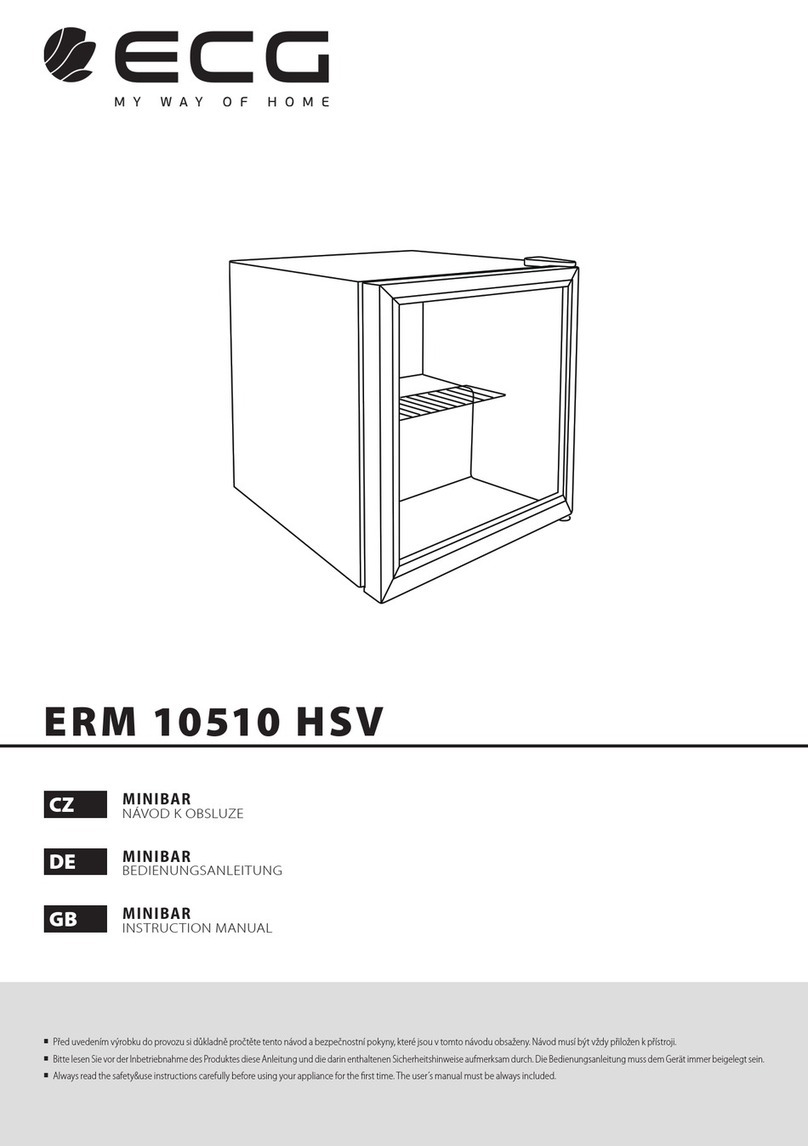
ECG
ECG ERM 10510 HSV User manual
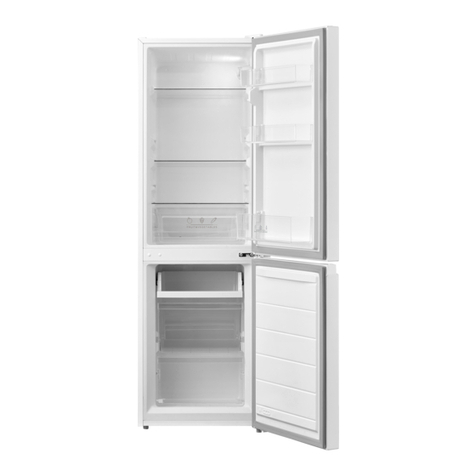
ECG
ECG ERB 21500 WF User manual
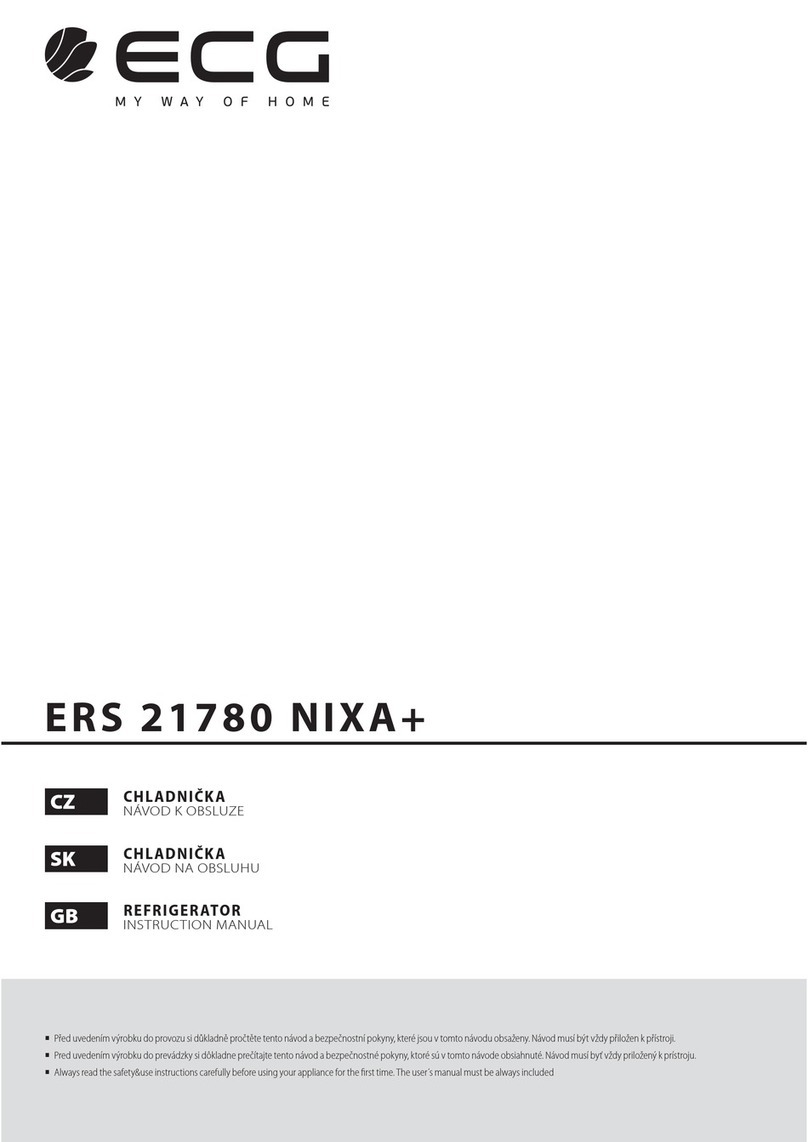
ECG
ECG ERS 21780 NIXA+ User manual
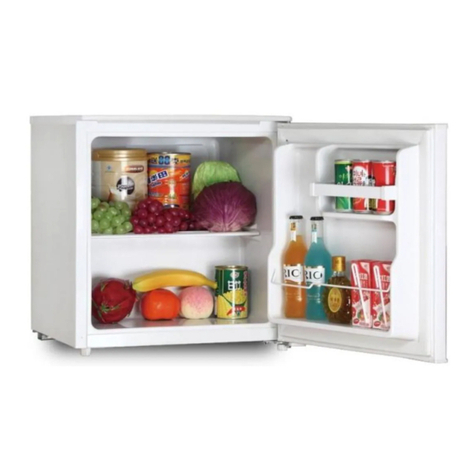
ECG
ECG ERM 10472 WA+ User manual

ECG
ECG ERS 21780 NWA+ User manual
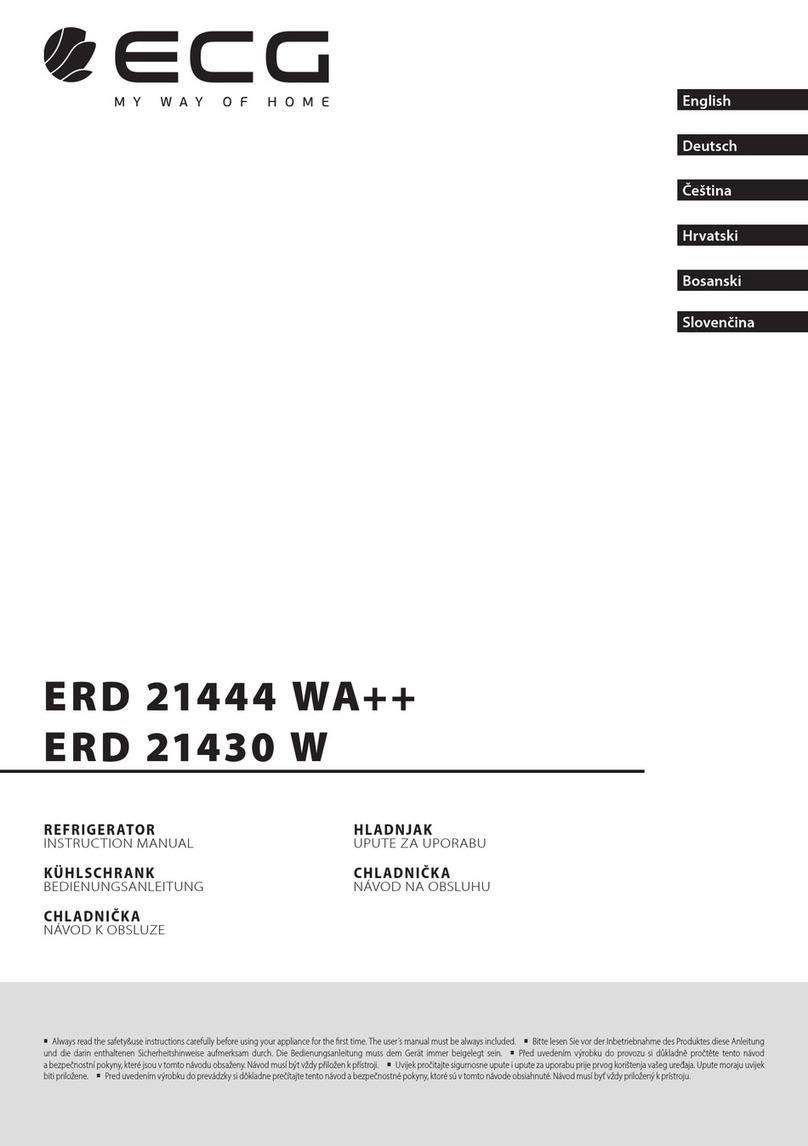
ECG
ECG ERD 21444 WA++ User manual
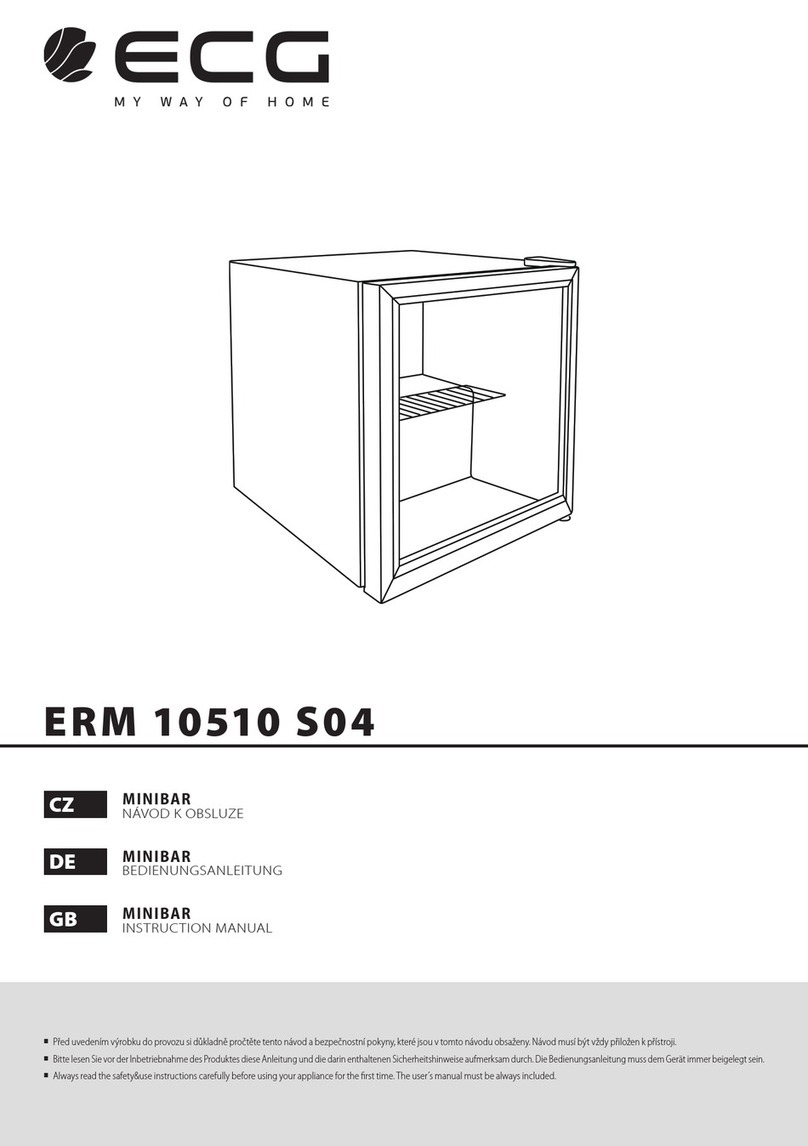
ECG
ECG ERM 10510 S04 User manual

ECG
ECG ERB 21860 NWA++ User manual
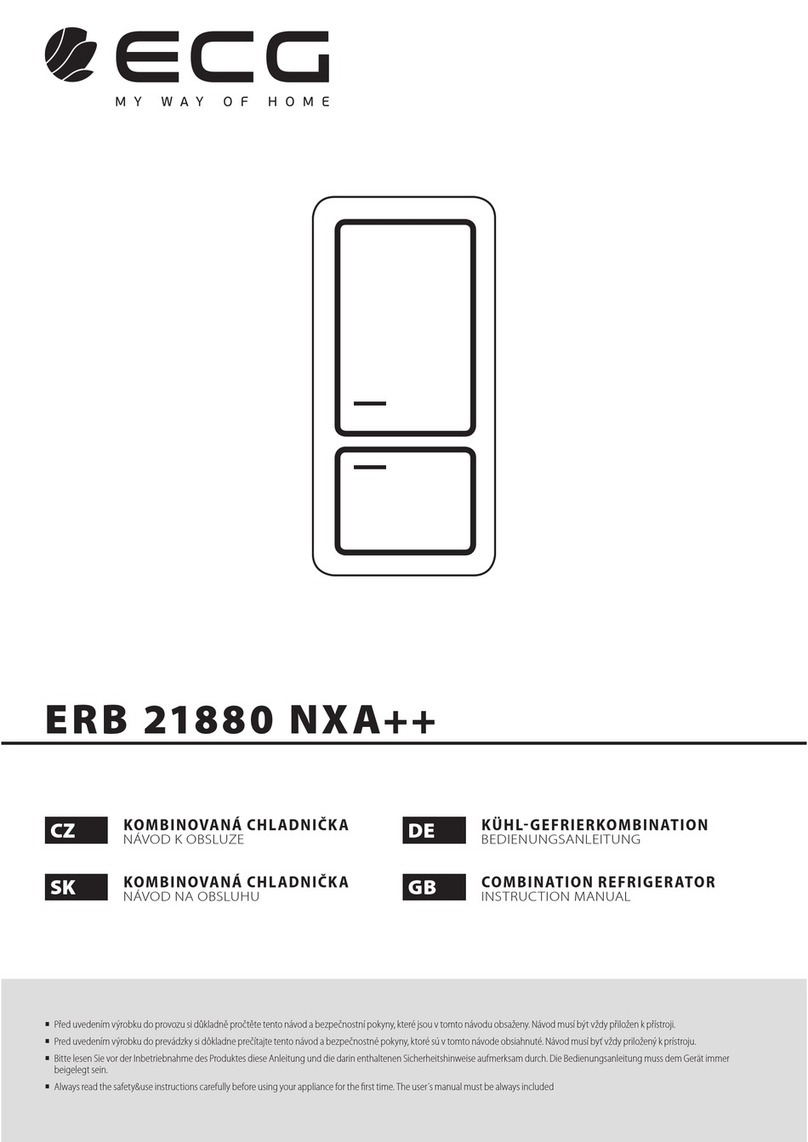
ECG
ECG ERB 21880 NXA++ User manual

ECG
ECG ERB 21420 W User manual
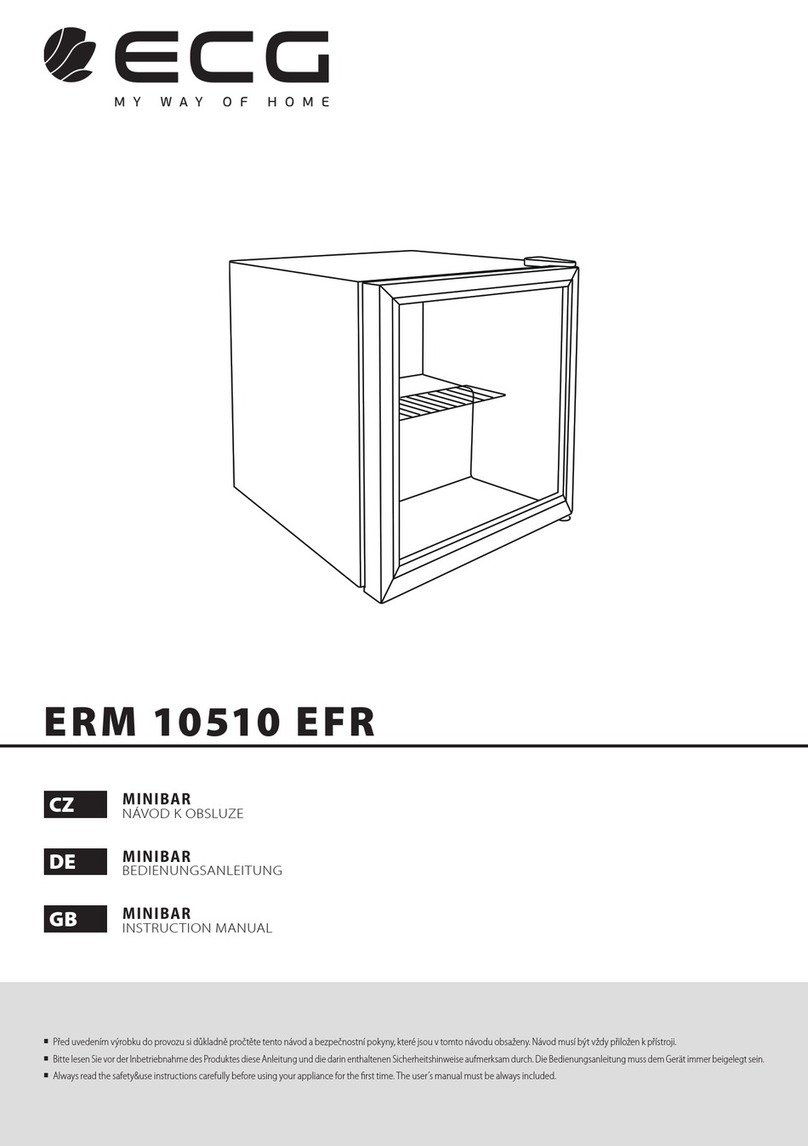
ECG
ECG ERM 10510 EFR User manual
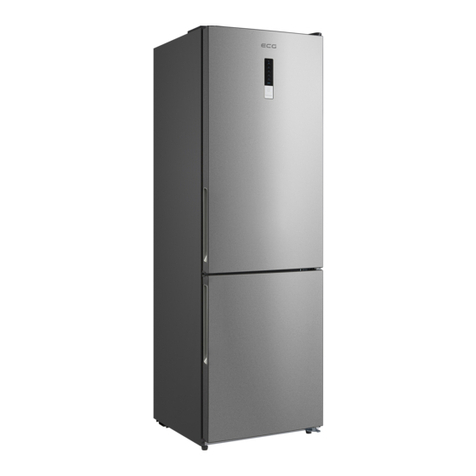
ECG
ECG ERB 21880 NXE User manual
